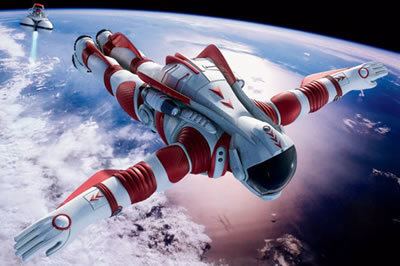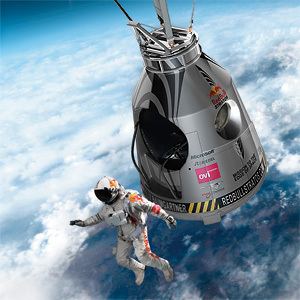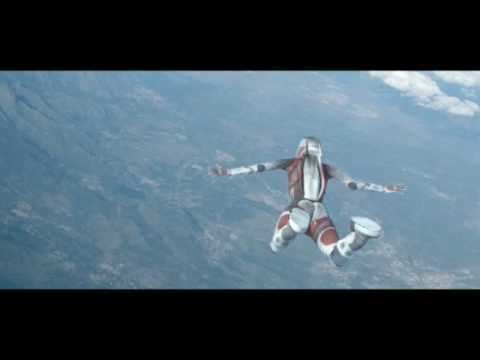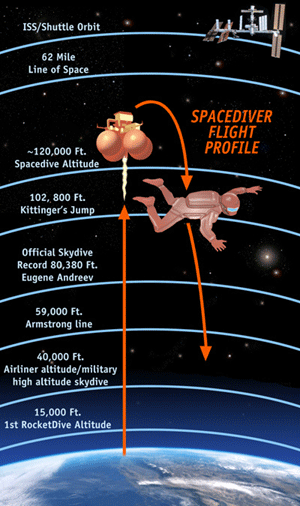 | ||
Space diving
Like skydiving, space diving refers to the act of jumping from an aircraft or spacecraft in outer space and falling to Earth's atmosphere before parachuting to a landing. The Kármán line is the internationally accepted definition as to where space begins at 100 km (62 mi) above sea level. This definition is accepted by the Fédération Aéronautique Internationale (FAI), which is an international standard setting and record-keeping body for aeronautics and astronautics. The United States Air Force uses 50 mi (80 km) to award astronaut wings.
Contents

A number of successful space dives from the stratosphere have been completed to date. In 1959 Joseph Kittinger accomplished a jump from 74,700 feet (22.8 km); he then set a long-standing record in 1960 when he jumped from 102,800 feet (31.3 km). In 1962 Yevgeni Andreyev jumped from 83,523 feet (25.458 km) and set a longest free fall record that was surpassed by Felix Baumgartner who made three jumps in 2012 from 71,581 feet (21.818 km), 96,640 feet (29.46 km) and 128,000 feet (39 km). Alan Eustace set the current world record highest and longest free fall jump in 2014 when he jumped from 135,908 feet (41.425 km).

Higher jumps from the mesosphere or thermosphere have yet to be successfully performed, though Orbital Outfitters is working to create a suit that will enable safe space diving. Space diving from beyond the stratosphere was first imagined in 1934, appearing in E.E. "Doc" Smith's science fiction novel Triplanetary.

History

The first stratospheric space dive was in 1959 when Colonel Joseph William Kittinger II (born July 27, 1928 in Tampa, Florida, United States) a former command pilot, career military officer and retired Colonel in the United States Air Force dived from a high-altitude balloon. He participated in Project Excelsior, testing the effects on pilots of ejecting at high altitude and in 1960 set a record for the longest skydive, from a height greater than 102,000 feet (31 km).

On 1 November 1962, Yevgeni Andreyev and Pyotr Dolgov ascended from Volsk, near Saratov. Andreyev jumped from the capsule at 83,523 feet (25.458 km) and free fell 80,380 feet (24.50 km) before successfully deploying his parachute. Dolgov remained in the capsule and ascended to 93,970 feet (28.64 km). Dolgov was primarily testing an experimental pressure suit, and would have deployed a drogue chute like Kittinger's earlier jump. As he exited the gondola, he struck his helmet and cracked the visor, leading to depressurization and his death.

In 1965-1966 Nick Piantanida accomplished a set of unsuccessful attempts to jump from 123,500 feet (37.6 km) and 120,000 feet (37 km). During the last attempt Piantanida's face mask had depressurized. His Ground controllers immediately jettisoned the balloon at close to 56,000 feet (17,000 m). Piantanida barely survived the fall, and the lack of oxygen left him brain damaged and in a coma from which he never recovered.
In 2012, Felix Baumgartner broke Kittinger's highest altitude and Andreyev's longest free fall records, when on October 14 he jumped from over 128,000 ft (39 km).
In 2014, Alan Eustace set the current world record highest and longest free fall jump when he jumped from 135,908 feet (41.425 km) and remained in free fall for 123,334 feet (37.592 km).
Challenges to safe space diving
There are several technical requirements and challenges to the possibility of space jumping. These requirements would be somewhat eased when entering the atmosphere from a simple drop, where the heat of reentry would be considerably less than that of reentering from orbit. Parachutes would require increased strength to slow the higher weights associated with the added equipment.
NASA is known to have investigated the concept in case of an emergency situation on the shuttle where alternative methods of reentry are not available. However, such planning has not moved beyond the conceptual stage given the high energies involved in reentry from orbital speeds.
